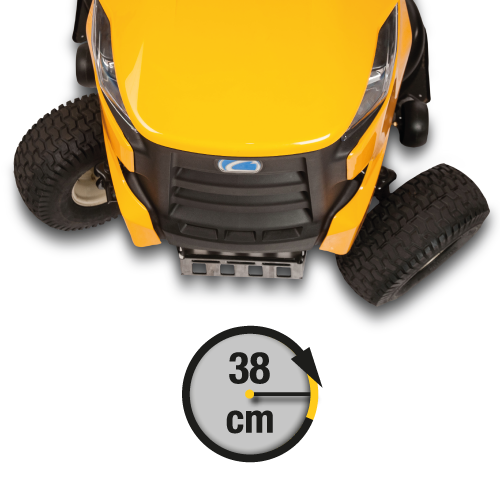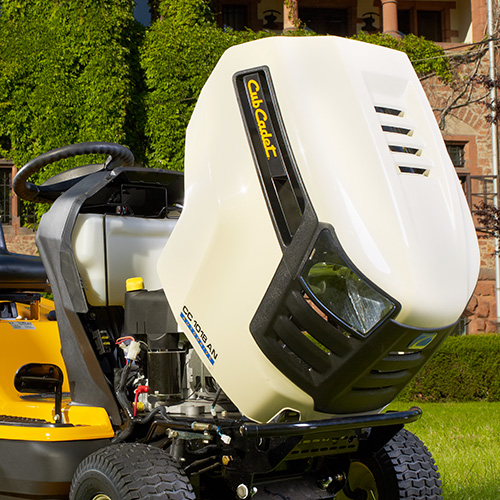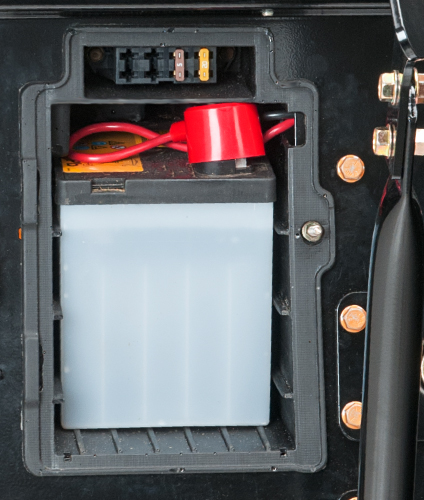What oil does a lawn mower need?
In order for lawn mowers to run smoothly over the long run, they need oil. Therefore, it is important not to use just an ordinary motor vehicle engine oil, but rather a special lawn mower oil that is optimally matched with two- or four-stroke engines.
Most lawn mowers are now equipped with four-stroke engines that need to be supplied with engine oil in addition to gasoline. Doing so helps the functionality of the device and helps prevent damage to the engine as a result of insufficient lubrication. Using a simple oil for motor vehicles is by no means recommended. Instead, it is better to use a special lawn mower oil .

Two-stroke or four-stroke engine
Step one should be to find out is whether the lawn mower has a two-stroke or four-stroke engine. In two-stroke engines, the oil burns together with the gasoline. For this purpose, it is either added to the tank in a mixed ratio together with the gasoline (mixed lubrication) or the device has a separate oil tank (separate lubrication) where it lubricates the engine.
In this case, a non-self-mixing two-stroke oil is used. Unlike the self-mixing one, which you put into the tank together with the gasoline in a predetermined mixing ratio (specified in the operating instructions), you fill the non-self-mixing one into the oil tank. There are special oils for two-stroke engines.
In four-stroke engines, the oil does not burn but rather circulates through the engine from the oil tank and provides adequate lubrication. Since it, therefore, does not need to burn cleanly, it is characterized by different properties than a two-stroke engine oil. Engine oils are identified by the SAE designation.
SAE classification for lawn mower oils
Behind the abbreviation SAE are two number ranges. On the one hand, these provide information about the viscosity. On the other, they show suitable temperature ranges. So, a designation for a lawn mower oil might be SAE 10W-30, for example.
The lower the number before the W, which generally denotes the flow properties, the more fluid the oil, i.e. it is more suitable for cold temperatures. This ensures lubrication of the engine immediately after starting and reduces wear.
The number after the W indicates the load capacity under heat: the larger the number, the higher the viscosity.


Possible SAE classes for lawn mowers
SAE 10W-30
- for temperatures between -18°C and +38°C (-0.4°F and +100.4°F)
- engine is easy to start at low temperatures
- oil consumption increases from 27°C (80.6°F) for outside temperature
SAE 5W-30
- synthetic
- for temperatures between -30°C and +40°C (-22°F and +104°F)
- ideal for frequent lawn mower use at temperatures below 5°C (41°F)
- improved engine start at all temperatures
- low oil consumption
SAE 15W-50
- fully synthetic
- for temperatures between -6°C and plus 55°C (21.2°F and +131°F)
- ideal for frequent use at high temperatures
- reduced fuel consumption from 1-6%
Other specifications of lawn mower oil
In addition to the SAE classification, other specifications are rather confusing but often found regarding engine oils. In the so-called API specifications, for example, the letter S is found for four-stroke lawn mower oil or gasoline engines in general, whereas C stands for diesel engines. The second letter indicates the quality grade. The further the letter falls in the alphabet, the higher the quality of oil. SN is currently the maximum quality; for lawn mowers, it should be at least SG.

Mineral oil or synthetic oil for lawn mowers
Engine oils are available in mineral oil, synthetic oil or fully synthetic oil. Synthetic oil is somewhat more expensive than mineral oil due to the production process. It is characterized as having better flow properties at low temperatures, has a higher temperature stability and is more efficient than mineral oil. Overall, the quality is better and the engine is protected by the use of a synthetic oil.
Automotive oil for lawn mowers is not recommended
Automotive oil is usually a so-called multigrade oil, while lawn mower oils are monograde. For automobiles, engine lubrication is immensely important at all times of the year, whereas for lawn mowers, it is usually only important when the temperature is above freezing. If you run a motor vehicle oil in your lawn mower, it will run as usual. However, the heavy lubrication will significantly increase the wear.
Maintenance of the lawn mower
It is important to check oil levels before each use. When cold, oil is stored completely in the crankcase, so you should not start your lawn mower before checking. As with a vehicle, there is a dipstick on the oil filler cap that indicates the oil level after it is pulled out. Clean the area around the cap before opening so that no dirt can contaminate the oil.
Ideally, the oil should have an amber color. However, due to abrasions and contamination in the engine, the color becomes darker over time. Moreover, the functionality of the oil decreases, so an oil change is advisable. For classic lawn mowers, this should be done after about 25 hours of operation; for new machines, it may be necessary to change the oil after a shorter period of time since abrasions can occur more frequently at the beginning.
There is a drain plug for releasing the oil. Place an oil drain pan under your mower and open it to simply drain the oil. Then, properly dispose of the used oil and refill with new.
Although using automotive oil generally does not directly cause total engine failure, it can significantly increase wear. Therefore, for the longest possible engine life, it is recommended that you use a suitable engine oil for your lawn mower.